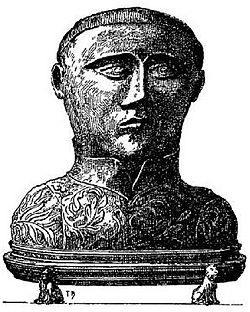Winwaloe(Breton:Gwenole;French:Guénolé;Latin:WinwallusorWinwalœus;c. 460– 3 March 532) was the founder and first abbot ofLandévennec Abbey(literally "Lannof Venec "), also known as the Monastery of Winwaloe. It was just south ofBrestinBrittany,now part ofFrance.
Saint Winwaloe | |
|---|---|
 Portrait of a silver bust of Saint Guénolé, 1901 | |
| Died | 3 March 532 Landévennec Abbey |
| Venerated in | Eastern Orthodox Church Catholic Church |
| Feast | 3 March |
| Patronage | Fertility |
Life
editWinwaloe was the son ofFragan(or Fracan), a prince ofDumnonia,and his wifeGwen the Three-Breasted,who had fled to Brittany to avoid the plague.[1][2]
Winwaloe was born about 460, apparently atPlouguin,nearSaint-Pabu,[2]where his supposed place of birth, a feudal hillock, can still be seen. Winwaloe grew up inPloufragannearSaint-Brieucwith his brotherWethenoc,and his brotherJacut.[2]They were later joined by a sister,Creirwy,and still later by half-brotherCadfan.[3]He was educated byBudocofDolon Lavret island in theBréhatarchipelago nearPaimpol.
As a young man Winwaloe conceived a wish to visitIrelandto see the remains ofSaint Patrick,who had just died. However, the saint appeared to him in a dream to say that it would be better to remain in Brittany and found an abbey. So, with eleven of Budoc's other disciples, he set up a smallmonasteryon theÎle de Tibidy,at the mouth of the Faou. However it was so inhospitable that after three years, he miraculously opened a passage through the sea to found anotherabbeyon the opposite bank of the Landévennec estuary.
Winwaloe died at his monastery on 3 March 532.
Veneration
editWinwaloe was venerated as a saint at Landévennec untilVikinginvasions in 914 forced themonksto flee, with his body, toChâteau-du-Loirand thenMontreuil-sur-Mer.Hisrelicswere often taken on procession through the town.
Winwaloe's shrine was destroyed during theFrench Revolutionin 1793.
He apparently acquired apriapicreputation through confusion of his name with the wordgignere(Frenchengendrer,"to beget" ) and was thus a patron of fertility as one of thephallic saints.[4]He is also the patron of Saint-Guénolé inPenmarch,Finistère.
InCornwall,Winwaloe is the patron of the churches atTremaine,St Wynwallow's Church, Landewednack,GunwalloeandPoundstockas well asEast PortlemouthinDevonand two lost chapels inWales.His feast day is 28 April and Gunwalloe feast is celebrated on the last Sunday of April.[5]The churches ofSt Twynnells,nearPembroke, PembrokeshireandWonastow,Monmouthshiremay have been originally dedicated to him.[6]They were probably founded by his successor at Landévennec,Gwenhael,who certainly made trips toGreat Britain.Exeter Cathedral,Glastonbury Abbey,Abingdon AbbeyandWaltham Abbey Churchheld small relics. He was also popular inEast Angliawhere the abbey at Montreuil had a daughter house;St Winwaloe PrioryinNorfolkwas dedicated to him.
See also
editReferences
edit- ^Vita Sancti Wingualoei,by Wrdestin (Vurdestinus) (9th century) inGilbert H. Doble'sThe Saints of Cornwall; Part 2: Saints of the Lizard District.Truro: Dean and Chapter; pp. 61-92
- ^abcButler, Alban.The lives of the fathers, martyrs, and other principal saints,volume 1, p. 275 (Henry & Co. 1857).
- ^Baring-Gould, Sabine and Fisher, John.The Lives of the British Saints: The Saints of Wales and Cornwall and Such Irish Saints as Have Dedications in Britain,Volume 2, p. 9 (C. J. Clark, 1908).
- ^"The Minor Themes".Archivedfrom the original on 9 May 2008.Retrieved5 June2008.
- ^Cornish Church Guide(1925) Truro: Blackford; p. 11
- ^Bowen, E. G. (1969)Saints, Seaways and Settlements.Cardiff: University of Wales PressISBN0-7083-0650-0(2nd ed. 1977), p. 189
Main sources
edit- Butler, Alban (1815),The Lives of the Fathers, Martyrs, and Other Principal Saints: Compiled from Original Monuments and Other Authentic Records, Illustrated with the Remarks of Judicious Modern Critics and Historians,J. Murphy,archivedfrom the original on 24 July 2021,retrieved24 July2021
- Doble, Gilbert H.(1962).The Saints of Cornwall Part II.Truro: Dean and Chapter of Truro. pp. 59–108.
- Latouche, Robert (1911).Mélanges d'histoire de Cornouaille (VI-XI siècle).Paris: Honoré Champion. (Bibliothèque de l'école pratique des hautes études, Vol. 192), pp. 2–39. (showing that the documents and the life are forgeries)
- Ranbeck, Father Aegedius, O.S.B (1896), Father J. Alphonsus Morrall, O.S.B. (ed.),Saints of the Order of Saint Benedict, January, February, March,translated by J P Molohan, M.A., London, England,archivedfrom the original on 24 July 2021,retrieved24 July2021– via CatholicSaints.info
{{citation}}:CS1 maint: location missing publisher (link) CS1 maint: multiple names: authors list (link)
External links
edit